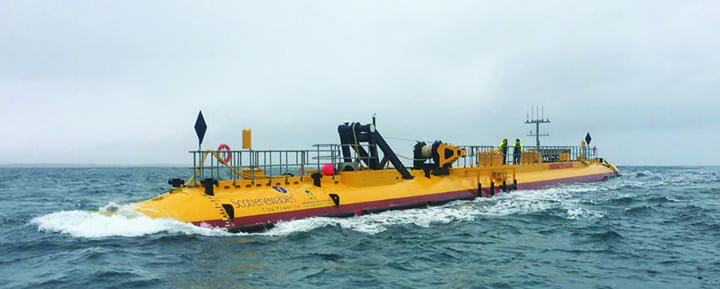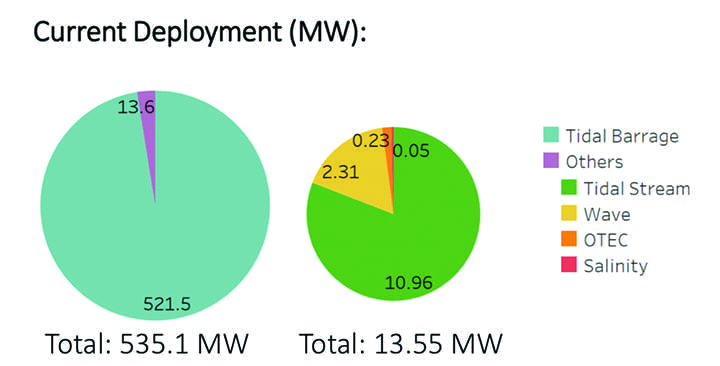Islands: An Ocean of Potential for Marine Energy
The post Islands: An Ocean of Potential for Marine Energy appeared first on POWER Magazine.

While island governments are exploring marine power technologies as serious options for future resources to replace diesel, technology developers are looking at improved value through new revenue streams, such as desalination and hydrogen production.
Energy experts have lauded ocean power's vast potential for decades, but few technologies have shifted from the research and development to commercial stage. According to Judit Hecke, a member of the International Renewable Energy Agency's (IRENA's) Innovation Team, of four main technologies that constitute the fledgling sector-tidal energy, wave energy, ocean thermal energy conversion (OTEC), and salinity gradient-most of the 535 MW of ocean energy capacity currently deployed worldwide are tidal barrage systems, such as in France and South Korea.
 |
1. The bulk of currently deployed ocean power installations to date are tidal barrage systems, followed on a much smaller scale by demonstrations for tidal stream, wave, ocean thermal energy conversion (OTEC), and salinity gradient technology. Source: International Renewable Energy Agency |
This is the only ocean energy source that has already reached full commercial maturity," Hecke explained in May (Figure 1). Of the smaller 13.6 MW of other" technologies, tidal stream and wave energy lead developmental efforts, which also corresponds to the technology readiness levels of the respecting technologies," she said.
But far from indicating growth in the sector is stagnant, Hecke noted the current ocean power fleet is set to see a stunning overhaul over the next decade. There is up to around 3.7 GW of capacity in the pipeline at the moment," she said. The majority of this capacity is tidal stream, with wave energy making up most of the balance.
Despite the pandemic, 2020, specifically, is turning out to be a big year" for emerging ocean power technologies, Hecke said. Developers are gearing up to deploy up to 24 MW-15 MW of tidal stream and 9 MW of wave energy-with some activity on nearly every continent. This is also in line with IRENA's forecasts that by 2030 around 10 GW of ocean energy should be installed," Hecke said.
While more details will be available in a forthcoming IRENA report, the agency attributes the surge to two key drivers: decarbonization and decentralization. Because those deployments indicate tidal stream and wave ocean power technologies are reaching technical maturity, the sector appears to have begun to shift its focus from research and development to reducing capital costs to improve the economic case for adoption. All over the world, developers are exploring new business models, for example, that leverage synergies with related markets to allow projects to become more viable and to bring down costs," Hecke noted. That entails two directions: coupling with other renewables and coupling with other offshore sectors to net new end-users under a Blue Economy," an umbrella term that describes sustainability efforts that use ocean resources for economic growth. The markets that are perhaps best suited to ocean power entry, because they enable these ideal pre-conditions, are islands, she said.
Islands-and especially islands from the Small Island Developing States (SIDS) group, such as those in the Caribbean, the Indian Ocean, West Africa, and the Pacific-typically share the same characteristics. Because they have land restrictions, isolated grids, and few natural resources, they are often dependent on imported oil or diesel for power production, which can be costly and polluting.
As Ryan Cobb from the Belize Ministry of Public Service, Energy and Public Utilities noted at an IRENA-hosted conference held last October, while costs for wind and solar are falling, and many governments have set ambitions to increase renewable production, challenges with intermittency can be allayed by the predictability of tides. Other experts at the conference noted ocean power can play an immense added role in expanding access to produce hydrogen, or to provide desalination and potable water.
A Wave of New ActivityFrom a developer's standpoint, islands offer an open testing ground to help incorporate a number of these new value steams. Testing has produced promising results.
Among notable demonstrations are those backed by governments. In China, for example, more than 20 institutes and universities are exploring tidal current technologies and have so far deployed several prototypes from 60 kW to 650 kW near Zhoushan Islands. The Guangzhou Institute of Energy Conversion (GIEC), China Southern Power Grid, China Merchants Heavy Industry Co., and other partners last year also launched the construction of two wave energy converter (WEC) platforms (a total of 500 kW), anticipating they will be completed and deployed on Wanshan Island in an open-sea test this year.
In the U.S., perhaps the most notable project is Verdant Power's developing tidal current project in the East River near New York City; the company is also exploring converting the Roosevelt Island Tidal Energy project to a fully functioning test and demonstration facility for distributed generation, energy storage, and electric vehicle charging stations. And in Australia, Wave Swell Energy began construction of its 250-kW wave energy device in 2019, with planned deployment this year in King Island, Tasmania.
 |
2. A notable project planned under the European Union's Horizon 2020 program is the Floating Tidal Energy Commercialisation (FloTEC) project, which will demonstrate the potential for floating tidal stream turbines to provide low-cost, high-value energy. The project, slated to end in February 2021, will test a 4-MW array comprising UK firm Orbital Marine Power's SR2000-M2 and SR2000-M1 turbines. Courtesy: Orbital Marine |
The European Union (EU), meanwhile, in 2017 launched Clean Energy of EU Islands," a policy initiative that is exploring coupling with energy storage facilities. The region has also mobilized 100 million under the Horizon 2020 program to enable island power systems by 2023 (Figure 2).
Among projects making waves with that funding are two demonstrations by developer Wavepiston: a Wavepiston wave energy convertor (WEC) at the PLOCAN test platform in Gran Canaria, the biggest of Spain's Canary Islands, for conversion to electricity in 2020; and a demonstration of a wave-to-energy and water system on a tourist island, using the pressurized seawater for both electricity production and desalination via reverse osmosis in 2021. In June, meanwhile, Minesto, maker of an innovative underwater kite technology, installed the first of two 100-kW turbines planned for the Faroe Islands, a project for which it has secured a power purchase agreement with local electric utility SEV, which is seeking to scrap its reliance on diesel and produce the bulk of its power with tidal current energy.
Another project highlighted by IRENA that demonstrates system coupling is the 2017-commissioned Surf-n-Turf project in the Orkney Islands in Scotland, which harnesses tidal and wind power and stores it as hydrogen. Meanwhile, the European Marine Energy Centre is looking to connect a 2-MW tidal array to the European grid along with a 500-kW electrolyzer-with the ability to ramp up to 1 MW-to produce green hydrogen under the ITEG (Integrating Tidal Energy into the European Grid) project.
France last year also launched the notable Progressive Hybrid Architecture for Renewable Energy Solutions (PHARES) project, a multi-energy system that includes solar, wind, storage, and tidal power (from two 500-kW horizontal-axis turbines) in a microgrid on Ushant Island. Notably, ADEME, the French agency focused on ecological energy transition policies, is also exploring an original salinity gradient energy converter for desalination plants under the Sarbacanne project.
Leveraging the Blue Economy'In tandem, tests are underway on Reunion Island in the Indian Ocean on a 2012-installed onshore OTEC prototype. Another project on Reunion Island-Bois Rouge eco-technoport-is planned to explore renewable electricity production using OTEC for air conditioning, industrial cooling, aquaculture, desalination, potable water, and cosmetics production. In Japan, the Okinawa Prefectural Government and a consortium that includes Yokokawa Electric and Nagasaki University is exploring a 100-kW deep seawater OTEC project coupled with a 2-MW offshore floating wind turbine, a project the group has suggested will promote aquaculture, fishery, and cosmetics production.
OTEC exploration is also progressing in India, where the government has approved the construction of a new OTEC-powered desalination plant with a capacity of 100 cubic meters per day in Kavaratti, Lakshadweep Island. Last September, the Korea Research Institute of Ships and Ocean Engineering (KRISO) completed a short-term demonstration of an OTEC pilot in the East Sea as part of plans to develop a 1-MW OTEC demonstration plant on land in South Tarawa, Kiribati, which could come online in 2021. KRISO, notably, is also developing small oscillating water column wave energy converters, combined with breakwater and energy storage systems, to provide power to several off-grid remote islands in South Korea.
According to IRENA's Hecke, it's important to note the emphasis on aquaculture, desalination, and potable water generation, because all these sectors are expected to grow substantially." Other emerging uses include for fisheries and shipping. GEPS Techno, for example, in 2018 sold an anti-rolling tank" for installation in a Norwegian fishing vessel. The passive and autonomous anti-roll stabilization system generates power from the water load in motion activating turbines on both sides of the tank, reducing the vessels fuel consumption and ensuring the availability of power, even during a blackout.
Challenges PersistAccording to the International Energy Agency's (IEA's) Ocean Energy Systems (OES) technology collaboration program, however, to enable widespread adoption of ocean power on islands, several key hurdles will need to be overcome, specifically as they concern affordability, reliability, installability, operability, funding availability, capacity building, and standardization." Islands typically have local supply chains with few or no competitors (which has implications for the quantity and quality of available equipment), it notes.
Local grids can also be small and unstable, and remote locations can increase operational expenditures. Often, developers may not be able to secure support mechanisms for their power, and obtaining power purchase agreements may be a long and complex process. The relative newness of the technology may also pose a hindrance in securing investors, as well as to obtain the right insurance, which is key to project bankability. Novelty may also deter social acceptance, result in operating equipment with ill-equipped workers, and complicate natural disaster preparations.
Some ways developers could address these include leveraging information and knowledge sharing offered by organizations like IRENA and the IEA; engaging local communities early; and making grid reliability part of the value proposition. Countries interested in making ocean power a major part of portfolios could also pursue long-term policies to help developers cut risks by, for example, adopting ocean power as part of the Blue Economy, rather than encouraging piecemeal development as part of a niche market, the IEA OES said.
-Sonal Patelis a POWER senior associate editor.
The post Islands: An Ocean of Potential for Marine Energy appeared first on POWER Magazine.